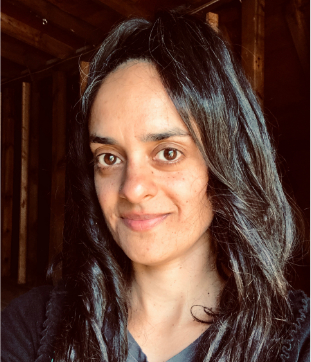Mali Sastri is a registered Voice Movement Therapy practitioner based in Boston, MA. She trained with VMT founder Paul Newham, and with Anne Brownell and Christine Isherwood in London, UK from 1999 – 2001.
For the past eleven years, Mali has worked with individuals and groups, primarily in the Boston area. Since 2012, she has been part of the music education program at Tunefoolery, a Boston non-profit for musicians in mental health recovery.
Mali’s work rides the edge between artistic and therapeutic practice, with an emphasis on breath and the song-as-container. She herself is a singer, songwriter, composer, performer, and artist-practitioner — a forever student and lover of voice.
Mali offers sessions via Zoom during the pandemic
Discover More
Introduction
Testimonials:
“Mali Sastri is a gifted Voice Movement Therapist, individual and group facilitator, voice and songwriting coach, and mentor. She has many human gifts of compassion, insight, and the ability to meet clients where they are at to help support and reflect their/our journeys with voice, sound, movement, words, emotions, feelings. Mali intuitively and creatively understands the inner workings and complexities of her client’s soul-selves and is able to profoundly support their/our individual and group process and growth with precision, skill, imagination and creativity. Mali draws upon her own journey as a talented and experienced singer-songwriter-performer to help inform and best support her client’s voice exploration, skill building and growth. It is both joyful and meaningful to work with Mali in Voice Movement Therapy sessions as well as within a group setting. She partners with each person she works with and engages with us with passion, care, enthusiasm, commitment, joy, openness and imagination.” — Lisa
“Voice movement therapy (VMT) is a major part of my pain management program. When I started doing it, I wasnʼt looking to improve my health but months later, after much pain and surgery, I realized I hadnʼt needed a massage or trigger point injections to get any stubborn muscles to relax in 11 months. That was all due to VMT.
I grew up singing and dancing. While I never had voice training, I sang for fun all the time. Dance was my emotional outlet. I took all sorts of dance classes — ballet, jazz, hip hop, modern, flamenco, ballroom and swing. But once pain and illness started preventing me from dancing, I was depressed I couldnʼt dance. I was depressed about how I was feeling, and I had no coping techniques other than dance. I decided to see if I could connect with my emotions using singing, and having learned about VMT, I thought that might be a good way to form those connections.
I was also frustrated because my voice had changed following my thyroidectomy, a common side effect. My voice would cut out even when I had breath left. I wasnʼt enjoying singing anymore, and I was hoping some experimentation would help me get used to my new voice. To learn about VMT, Iʼd suggest looking at this website. For me, the practice is on my own, with my instructor or in a workshop. VMT has a focus on how the body contributes to the voice and improvisation. You move and vocalize spontaneously, and you do exercises to get you to approach your voice differently. I compare it often to creative movement classes for little kids, preschool and improv.
My sessions, with my instructor Mali Sastri, have become very playful. Sometimes we work on a vocal technique or song, but a lot of the session is moving how my body seems to want to move and making sounds I want to make. And moving around is useful for my pain when it doesnʼt make it worse. When things got really bad pain-wise, she suggested we try doing the work from a pillow pile on the floor, which worked really well. Iʼve written five songs in the last year due to this work, and thatʼs amazing. But what is even more amazing to me is that I learned even more about how to cherish my body and be relaxed from this work than biofeedback, meditation for pain, breath-based meditation and lots of physical therapy.
Singing in the way I do with Mali meant learning to accept my belly. It meant learning a deep appreciation for breathing and noticing when and how I do it. And it turns out that being loose in my shoulders and face is important too. Mali notices when my shoulders are tense. She helps me find a way to stand that is erect and relaxed — the opposite of ballet. And our lessons helped me develop a muscle memory for a relaxed face and shoulders.
Thatʼs why I didnʼt need massage. Usually, I need massage because my bodyʼs reaction to pain is to tense everywhere. Now I notice when that is happening and I have techniques to release those tensions. The body acceptance and breath appreciation have also helped my meditation practice. It was amazing to find a creative outlet that helped me deal with the stress of my life, it was incredibly special to find a safe place to play and explore sound and movement. But when I realized that same activity also helped develop a better relationship with my body and a sense of physical ease, I knew Iʼd found an activity Iʼd prioritize for life.” -Anna Lisa Borsai

